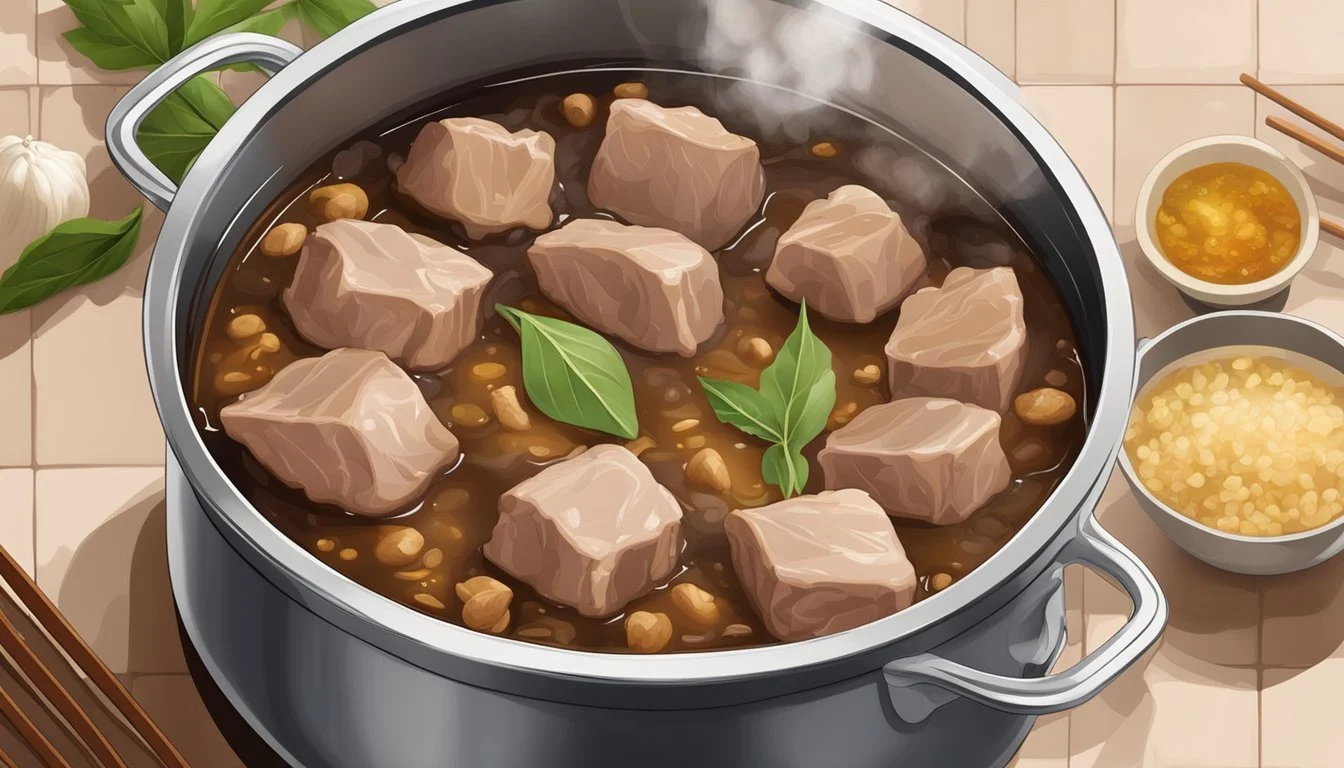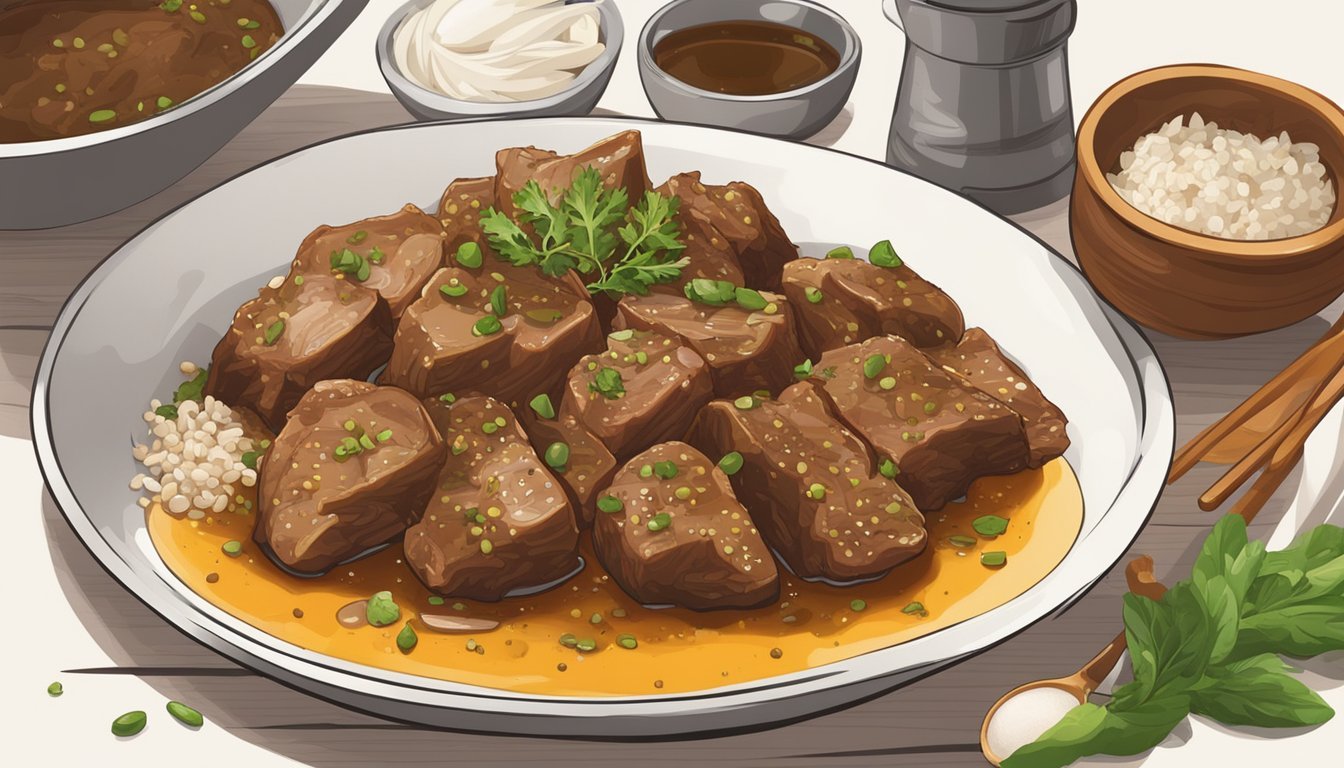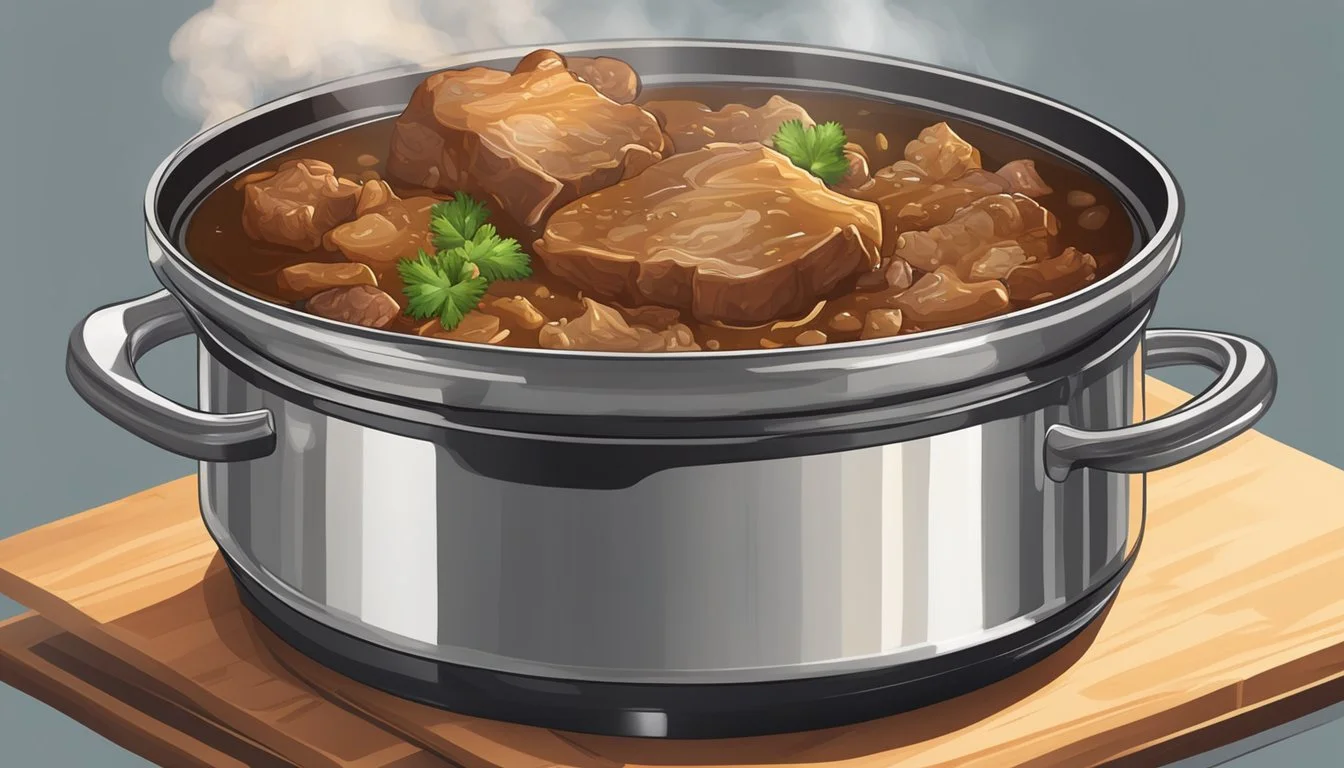Best Way to Reheat Pork Adobo
Tips for Maintaining Its Unique Taste
Pork adobo, a beloved dish hailing from the Philippines, is not only a staple but often considered the nation's unofficial national dish. Its rich combination of vinegar, soy sauce, garlic, bay leaves, and peppercorns creates a tangy, savory flavor profile that's deeply embedded in Filipino culture. The dish's hearty ingredients and complex flavors are meant to be savored, and its appeal often extends beyond the initial meal, with leftovers being a common occurrence.
The challenge of reheating pork adobo lies in preserving its distinctive taste and tender texture. Care must be taken to ensure that the reheating process does not dry out the pork or cause the flavors to become muted. Using a gentle heat source and incorporating a small amount of additional liquid, such as water or broth, can facilitate even heating and maintain the moisture of the meat.
Maintaining the integrity of pork adobo when reheating requires a nuanced approach that respects the original cooking process. It's important to strike the right balance between achieving the desired warmth without altering the essential characteristics that make the dish so celebrated. By reheating it slowly and with care, one can ensure that the leftovers are just as enjoyable as when the dish was first prepared.
Understanding Adobo: A National Dish of the Philippines
Adobo, revered as a national dish, is a cornerstone of Filipino cuisine. A staple in the Philippines, it comprises a rich history characterized by regional nuances and a robust flavor profile. The dish embodies the perfect amalgam of savory and tangy tastes, traditionally involving meats like pork shoulder or chicken, although variations may include beef, fish, shrimp, and even tofu.
The quintessential Filipino adobo is marinated and simmered in an adobo sauce composed of soy sauce, vinegar, water, and seasoned with garlic, sugar, onions, peppercorns, and bay leaves. It builds its flavor profile on the balance between the salty depth of soy sauce and the sharp, acidic punch of vinegar.
Pork adobo, which might feature hearty cuts like pork belly, is particularly beloved. Called adobong baboy, this version is both tender and packed with taste. Similarly, chicken adobo leverages the protein's ability to soak up the marinade, delivering a meat that is flavorful throughout.
Common Ingredients Purpose Soy sauce Adds saltiness and umami Vinegar Provides acidity and tenderizes meat Water Balances intensity of flavors Garlic Infuses a pungent, earthy aroma Sugar Offers a hint of sweetness Bay leaves Introduces a subtle depth
Adobo recipes are as diverse as the archipelago's regions, with some recipes incorporating coconut milk for a creamier version or varying the protein base. Despite these variations, Filipino pork adobo remains a cherished dish, a cultural symbol, and a testament to both the unifying and distinctive aspects of Filipino cuisine.
Selecting the Right Pork Cut
The success of a pork adobo dish is influenced significantly by the cut of the pork chosen. Certain cuts balance the rich flavor and tenderness required for this traditional dish.
Pork Shoulder vs. Pork Belly
Pork Shoulder:
Tenderness: Slow cooking transforms pork shoulder into a tender delight, suitable for absorbing adobo's tangy flavors.
Fat Content: Moderate fat content enhances flavor without being overly greasy.
Richness: Pork belly adds a luxurious quality with its higher fat content, creating a sumptuous adobo.
Texture: The cut yields a soft yet decadent mouthfeel when stewed, giving each bite a balance of meat and melt-in-your-mouth fat.
Alternative Cuts for Pork Adobo
Pork Butt: Also known as Boston butt, this cut is similar to pork shoulder with a good balance of fat and lean meat, making it another ideal choice for adobo.
Pork Ribs: They can be used for a different textural experience. The bones add extra flavor, and the meat stays tender.
When preparing pork adobo, choosing the right cut ensures the protein remains the star of the dish, full of flavor and perfectly tender. Whether one opts for the traditional pork shoulder or the indulgent pork belly, or explores alternative cuts like pork butt and ribs, the key is slow cooking to achieve the characteristic savory profile of a classic pork adobo recipe.
Preparation: Marinating the Pork
The marination process is crucial for infusing pork adobo with its characteristic tangy and savory flavors. By allowing the meat to absorb a blend of traditional Filipino ingredients, each bite is ensured to be rich and flavorful.
Optimal Marinating Time
For pork adobo, marination should ideally last for a minimum of 1 hour to ensure that the pork absorbs the robust flavors of the marinade. However, for a deeper infusion that results in even more flavorful meat, letting it marinate overnight in the refrigerator is highly recommended.
Essential Ingredients for Marination
The following ingredients are essential for creating the traditional adobo marinade:
Soy Sauce: Acts as the salty base of the marinade, typically using standard soy sauce.
Vinegar: White vinegar is preferred for its sharp tanginess, which balances the soy sauce.
Garlic: Crushed or minced, garlic adds a pungent depth to the marinade.
Onions: Sliced or chopped onions provide a subtle sweetness and aromatic quality.
Sugar: A teaspoon or two of sugar can offset the acidity, contributing to the savory-sweet flavor profile.
Black Peppercorns: Left whole, they add a warm, piquant note.
Bay Leaf: Usually one or two leaves are enough to impart its herbal fragrance.
To prepare the pork for marinating, one should:
Cube or slice the pork into bite-sized pieces to ensure even marination.
Combine all the marinade ingredients in a bowl or ziplock bag.
Submerge the pork fully in the mixture to marinate.
This preparation stage sets the foundation for the adobo's flavor, making it a critical step before cooking.
Reheating Methods to Preserve Flavor and Tenderness
When reheating pork adobo, retaining its tangy and savory qualities, as well as the tenderness of the pork, is crucial. The methods chosen can greatly impact the moisture and flavor profile of the leftover adobo.
Oven-Based Reheating
The oven is an effective way to reheat pork adobo, ensuring even heat distribution without sacrificing tenderness. To start:
Preheat the oven to 325°F (163°C).
Place the leftover adobo in an oven-safe dish along with some of the sauce to prevent drying out.
Cover the dish with foil to keep the moisture intact.
Heat for about 10-15 minutes or until the internal temperature reaches 165°F (74°C).
This gentle warming process helps maintain the pork's tenderness and enhances the tangy adobo flavors.
Stovetop Simmering
Stovetop reheating captures the essence of the original cooking process and is best for preventing a dry outcome.
Heat a pan over medium heat and add the adobo along with some sauce or a splash of water if it appears dry.
Simmer gently with the lid on to keep the moisture circulating.
Cook until the meat is heated through, usually about 10 minutes, stirring occasionally.
Simmering not only preserves the savory taste but also helps in tenderizing the meat further.
Microwave Instructions
A microwave offers the quickest route for reheating pork adobo, although care must be taken not to overheat the dish.
Place the pork adobo in a microwave-safe container; ideally, an airtight container if coming directly from the refrigerator.
Add a tablespoon of water or sauce to combat dryness, and cover the container with a microwave-safe lid or plastic wrap.
Reheat on medium power in short bursts of 30 seconds, stirring in between, until the desired temperature is reached.
Using the microwave strategically can retain the sour and tangy flavors typical of adobo, while preserving the pork's moistness.
Avoiding Common Reheating Mistakes
Proper reheating is crucial for pork adobo to maintain its signature tenderness and sauciness. Avoiding the pitfalls of ending up with dry or tough meat, and inconsistent sauce consistency, can make all the difference.
Preventing Dry and Tough Meat
To keep pork adobo tender and moist during reheating, one should:
Use low heat: Gradually reheating on a low temperature setting in a skillet or a dutch oven helps retain the meat's moisture.
Add liquid: A small amount of water or broth can prevent the adobo from drying out. Incorporate a few tablespoons to the dish before heating.
Cover the dish: Utilize a lid to trap steam and heat, promoting even temperature distribution without losing moisture.
Attention to detail when reheating meat is as important as the cooking process itself.
Maintaining a Saucy Consistency
For a pork adobo sauce that maintains its characteristically tangy and savory profile:
Start with the sauce: Separately heat the sauce, allowing for any adjustments to the consistency before combining it with the meat.
Adjust if necessary: If the sauce has thickened too much during storage, thin it out with a bit of broth or water; for a thicker consistency, a slurry made from cornstarch and water can be gently stirred in.
Combine and reheat: Once the sauce is at the desired consistency, reintroduce the pork, and simmer them together briefly to achieve a cohesive flavor.
A mindful approach to reheating adobo ensures every element of the dish — from the succulent pieces of pork to the vibrant sauce — is as close to freshly cooked as possible.
Serving and Pairing Ideas
When seeking the perfect accompaniment to pork adobo, one generally aims to balance the dish's rich tangy and savory flavors. Optimal pairings include a variety of rice dishes and vegetables, or even reinventing the leftovers into a new meal.
Rice Dish Combinations
For a classic Filipino touch, Jasmine rice is the quintessential base. Its fragrance complements the hearty flavors of adobo. Garlic fried rice, known as sinangag, adds a garlicky crunch that contrasts well with the tender meat.
Steamed white rice: A simple, clean flavor that serves as a canvas for the adobo.
Garlic fried rice: For an aromatic twist that mirrors the robust adobo seasoning.
Vegetable Side Options
Vegetables offer a refreshing counterpoint to adobo's intensity. A staple choice could be a tossed green salad or stir-fried bok choy enriched with garlic. These sides provide not just contrast but also nutritional balance to the meal.
Simple potato salad: A cooling and creamy complement.
Stir-fried bok choy: Adds a touch of green crunch and garlic notes.
Creative Leftover Ideas
Transforming adobo leftovers inspires creativity while maintaining the dish's essence. Adobo fried rice masterfully repurposes both rice and adobo, while adding boiled eggs to the mix can introduce a new protein aspect.
Adobo fried rice: Incorporate chopped pork adobo into fried rice for an entrée that's both hearty and flavor-packed.
Adobo-stuffed bell peppers: A novel vessel for leftovers, combining them with rice and vegetables.
Storing Pork Adobo for Future Enjoyment
Proper storage techniques ensure that leftover adobo can be enjoyed with its tangy and savory flavor intact. Storing pork adobo in the refrigerator or freezer preserves its quality, maintaining the balance of flavors essential to the dish.
Refrigeration Guidelines
Duration: Refrigerate pork adobo within two hours of cooking to preserve its freshness. It should be consumed within three to four days.
Container: Store in an airtight container to prevent contamination and odor absorption from other foods.
Freezing and Thawing Procedures
Freeze: Place pork adobo in a freezer-safe airtight container or heavy-duty freezer bags. Properly stored, it can last for up to two months in the freezer.
Thawing: Thaw frozen adobo in the refrigerator overnight rather than at room temperature to reduce the risk of bacterial growth. Avoid using the microwave to prevent drying out the meat.
Adapting the Recipe for Different Dietary Requirements
When preparing Pork Adobo, one can take into consideration different dietary needs without compromising the dish’s distinct tangy and savory flavor. These adaptations ensure that individuals with gluten intolerance or those monitoring their sodium intake can still enjoy this classic Filipino dish.
Gluten-Free Adobo Variations
To make Pork Adobo gluten-free, it is important to focus on substitutes for soy sauce, a common source of gluten in the recipe. One can opt for gluten-free soy sauce or tamari as a direct substitute. The flavor profile remains similar, but the gluten content is eliminated. Here's a comparison of substitutes to consider:
Tamari: A Japanese sauce similar to traditional soy that usually (but not always) does not contain wheat.
Gluten-Free Soy Sauce: Specifically formulated to omit gluten while maintaining the taste of regular soy sauce.
For those concerned about losing the deeper color typically imparted by dark soy sauce, adding a small amount of molasses or brown sugar can help replicate the desired appearance.
Reducing Sodium Content
Pork Adobo's high sodium content comes chiefly from the soy sauce. To reduce sodium, one should use low-sodium soy sauce in replacement of regular soy sauces (light, dark, or traditional). This small change significantly decreases the overall sodium without drastically altering taste. Additionally, the selection of vinegar can influence the dish’s sodium content. Consider using these vinegars with naturally lower sodium content:
Apple Cider Vinegar
Rice Vinegar
White Wine Vinegar
Cane Vinegar (such as Datu Puti)
Coconut Vinegar
White Distilled Vinegar
Each vinegar introduces subtle variations in the adobo flavor profile while reducing sodium and ensuring the dish’s distinctive tanginess.
Exploring Regional Adobo Variations
Adobo, a beloved dish in the Philippines, presents a diverse spectrum of flavors reflecting the country's regional culinary practices. These variations often include unique ingredients and cooking methods that provide a distinct character to this classic dish.
Adobo sa Gata: Coconut Milk Infusion
In regions like Bicol, they introduce coconut milk to create a rich and creamy version known as Adobo sa Gata. The addition of coconut milk mellows the dish's sharpness while adding a luxurious texture and subtle sweetness that balances the traditional tangy flavors of vinegar and soy sauce.
Ingredients:
Coconut milk
Traditional adobo ingredients (soy sauce, vinegar, garlic, peppercorns, bay leaves)
Adobong Dilaw: Turmeric Twist
Adobong Dilaw stands out for its distinctive yellow color, owing to the use of turmeric. This variation hails from the Visayas and imparts a slightly earthy and peppery taste which complements the garlic and vinegar-driven profiles of the usual adobo recipe.
Key components:
Turmeric
Less reliance on soy sauce
Spanish and Asian Influences
The Spanish adobo differs significantly from its Filipino counterpart. It typically employs a rub made from oregano, salt, garlic, and vinegar. In contrast, Asian recipes might incorporate ingredients like soy sauce, mirin, or even oyster sauce, creating a fusion that nods to the historical trade routes that influenced the Philippines.
Notable influences:
Spanish: Oregano, rub-based marinades
Asian: Use of soy sauce and other Asian condiments
Each regional adobo carries a story of cultural exchange and local resources, offering a rich tapestry of tastes that testify to the dish's enduring appeal and adaptability.
Nutritional Guide for Pork Adobo
Pork Adobo, a beloved Filipino dish, is both tangy and savory. Its nutrition profile depends on the ingredients and portion sizes used. Here is an approximate breakdown for a standard serving:
Nutrient Amount per serving Calories 300-400 kcal Protein 20-30 g Carbohydrates 5-10 g Fat 20-25 g Fiber 0-1 g Sugars 1-2 g
This dish is high in protein, which is essential for muscle repair and growth. The pork provides a hearty dose of this macronutrient, making it a satisfying meal that can support an individual's dietary needs.
The caloric content can vary significantly depending on the cut of pork and the amount of oil used in preparation. Leaner cuts and measured cooking oils can result in fewer calories, while fattier cuts and liberal use of oil will increase the caloric content.
Pork Adobo may contain moderate amounts of carbohydrates from the addition of sugar and soy sauce. Those monitoring their carbohydrate intake should be mindful of these ingredients.
The fat content primarily comes from the pork used. While some fat is necessary for a balanced diet, it's important for individuals to be aware of their intake, especially since the dish can be high in saturated fats depending on the cut of pork.
This nutritional guide considers a commonly prepared Pork Adobo without additional garnishes or sides. If consumed with rice or other accompaniments, the nutritional values will change accordingly.
Instant Pot and Alternative Cooking Methods
The Instant Pot infuses robust flavors into Pork Adobo during reheating and is an excellent choice for preserving its signature tangy and savory notes. Similarly, slow cookers offer a gentle method that can also achieve desirable results.
Pressure Cooking Pork Adobo
Reheating Pork Adobo in an Instant Pot should be a controlled process. To begin, the pork adobo should be placed inside the pot. Then, the Instant Pot should be sealed and set to pressure cook on a low setting for a short duration to avoid overcooking. The sautéing function can be used before sealing if one wants to reintroduce flavors and bring the dish back to temperature gently. The pressure cooking process will ensure the meat remains tender and the sauce retains its complex flavor profile.
Slow Cooker Directions
In contrast, using a slow cooker requires setting the device on low heat. The pork adobo should be added to the slow cooker, and one should ensure that the meat is well-covered by the sauce. A lid is placed on top, and the adobo is left to warm through slowly, typically taking a few hours. While this method does not offer the same speed as an Instant Pot, it is particularly effective in keeping the pork moist and flavorful without any risk of drying out. This gentle cooking can be compared to the Dutch oven approach, harnessing a consistent, low heat to bring the dish to the ideal serving temperature.
By using these methods, one can reheat Pork Adobo to capture the essence of its flavor and bring it to the perfect warmth, ensuring a meal that is both comforting and delicious.
Maximizing Flavor: Techniques and Tips
When reheating pork adobo, preserving the tanginess and savoriness of the dish is essential. To ensure that the flavors are enhanced, rather than diminished, one should follow a couple of critical techniques.
Sautéing to Sear: This technique involves heating some oil in a skillet over medium-high heat and then adding the pork adobo to the pan. The goal is to lightly sear the pork on each side. This process not only warms the meat through but also creates a caramelized surface that amplifies the dish's inherent flavors.
Oil: Start with a thin layer of oil to avoid soaking the meat.
Heat: Keep it at medium-high; too hot and the meat may toughen up.
Time: Sear each side just until a golden crust forms.
Layering Flavors: It's essential to incorporate the aromatics like bay leaves and cracked black peppercorns into the reheating process. These should be added back into the pan if separated from the adobo. In some cases, one might consider making a flavor sachet with fresh spices to infuse during the reheating.
Bay Leaves: Vital for that classic adobo fragrance.
Black Pepper: Cracked whole peppercorns deliver a more intense flavor than pre-ground pepper.
Here's a step-wise breakdown:
Heat oil in the skillet over medium-high heat.
Return pork adobo and aromatics (bay leaves, black peppercorns) to the pan.
Sauté, gently turning the pork to ensure an even sear.
If the adobo has dried out, add a splash of water or adobo sauce to rehydrate.
One must avoid overheating as it can cause the pork to become tough and flavors to become muted. Gentle reheating with these tips can revitalize the adobo, making it nearly as delightful as when it was first cooked.
Conclusion: Enjoying the Richness of Pork Adobo
Pork Adobo stands as a triumph in Filipino cuisine, a dish that is both a savory delight and a comfort food staple. This easy recipe marries tangy vinegar and soy sauce, creating a harmony of flavors that are rich and satisfying. Upon reheating this classic dish, the objective remains to revive its full-bodied taste without compromising the tender quality of the pork.
Reheating Medium Method Stovetop Gently simmer in a pan with a splash of water. Microwave Use a low power setting and intermittently stir.
To maintain the integrity of the dish, it is crucial to:
Heat gently and gradually.
Add a small amount of water to reintroduce moisture and prevent drying out.
Storing the adobo correctly helps in preserving its flavors:
Airtight containers are recommended for refrigeration.
Freezer-safe bags or containers ensure longer storage without considerable loss of flavor.
They must remind themselves that the epitome of enjoying pork adobo is in its preparation and subsequent savoring. When reheated with care, pork adobo unveils its layers of tangy and savory essences, reminding one of its rightful place in the pantheon of comfort foods. The dish's hearty sauce, infused with garlic and traditional spices, is best served over steamed rice, allowing the grains to soak up every drop of flavorful goodness. In every bite, pork adobo speaks to the soul of Filipino cooking - hearty, robust, and teeming with the nostalgia of home.











